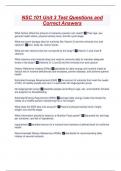NSC 101 Unit 3 Test Questions and
Correct Answers
What factors affect the amount of nutrients a person can need? ✅Their age, sex,
general health status, physical activity level, and life cycle stage.
What are some storage sites for nutrients like Vitamin D and the minerals iron and
calcium? ✅liver, body fat, and/or bones
What are two vitamins that are not stored by the body? ✅Vitamin C and most B
vitamins
What vitamins and minerals does one need to consume daily to maintain adequate
levels in the body? ✅Vitamins D, C and B and the minerals iron and calcium
Dietary Reference Intakes (DRIs) ✅standards for daily energy and nutrient intake to
reduce risk of nutrient deficiencies and excesses, prevent disease, and achieve optimal
health
Estimated Average Requirement (EAR) ✅the amount of nutrients that meet the needs
of 50% of healthy people who are in a particular life stage/gender group
life stage/gender group ✅classifies people according to age, sex, and whether females
are pregnant or breastfeeding
Estimated Energy Requirement (EER) ✅average daily energy intake that meets the
needs of a healthy person maintaining his or her weight
What does the EER take into account? ✅Person's physical activity level, height,
weight, sex and life stage.
What information should be listed on a Nutrition Facts panel? ✅Saturated fat, servings
per container, and list of ingredients.
requirement ✅smallest amount of a nutrient that maintains a defined level of nutritional
health
Recommended Dietary Allowances (RDAs) ✅standards for recommending daily
intakes of several nutrients
, Adequate Intakes (AIs) ✅dietary recommendations that assume a population's
average daily nutrient intakes are adequate because no deficiency diseases are present
Tolerable Upper Intake Level (Upper Level or UL) ✅standard representing the highest
average amount of a nutrient that's unlikely to be harmful when consumed daily
Acceptable Macronutrient Distribution Ranges (AMDRs) ✅macronutrient intake ranges
that are nutritionally adequate and may reduce the risk of diet-related chronic diseases
whole grains ✅the entire, ground, cracked, or flaked seeds of cereal grains, such as
wheat, buckwheat, oats, corn, rice, wild rice, rye, and barley
Examples of nutrients required on the Nutrition Facts panel: ✅Vitamin D, Saturated
Fats, Sodium, Potassium
What are true about facts about the percentages of Daily Values when applied to the
Nutrition Facts food label? ✅Is based on the 2000 calorie diet that allows for easy
comparison among similar foods.
Also requires people with more or less than 2000 calorie diet to make adjustments
The Nutrition Facts panel must provide info about: ✅the food's total fat, specific fats
(saturated and trans), cholesterol, sodium, total carbs, fiber, sugars, protein, vitamin A,
vitamin C, calcium and iron contents.
enrichment ✅addition of iron, thiamin, riboflavin, niacin, and folic acid to cereal grain
products
fortification ✅addition of nutrients to food
What vitamins and minerals are in many dairy products? ✅protein, phosphorus and
potassium (minerals), calcium, and the vitamins A and D, and riboflavin.
Which of the following is an example of a health claim? ✅Correct: Fiber can lower
cholesterol
Wrong: Calcium builds strong bones
Vitamins can help maintain immune health.
What are fruits a good source of? ✅low fat, good source of phytochemicals and
micronutrients, especially potassium and vitamins C and folate.
What are vegetables a good source of? ✅Micronutrients, fiber and phytochemicals
Also low in fat and energy




